by Lisa Cooke | Sep 21, 2017 | 01 What's New, Conferences
You’re invited to join Lisa Louise Cooke for a Roswell, NM genealogy seminar. “Solving Family History Mysteries with Lisa Louise Cooke” will be held on Saturday, October 21, 2017 as the Wilson-Cobb History and Genealogy Library Annual Workshop. Please come!
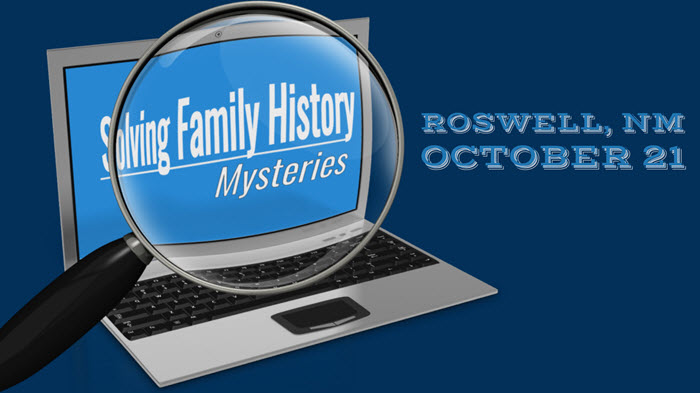
Roswell, NM Genealogy Seminar with Lisa Louise Cooke
The Wilson-Cobb Library in Roswell, New Mexico is hosting Lisa Louise Cooke for an exciting, informative all-day workshop that will help you solve your family history mysteries! Here’s what’s happening:
What: Solving Family History Mysteries with Lisa Louise Cooke
Where: Roswell Civic and Convention Center, 912 N Main St, Roswell, NM 88201
When: Saturday, October 21, 2017, 9:00 am – 4:00 pm (On-site registration opens at 8:30 am)
Hosted by: Wilson-Cobb History and Genealogy Library
Registration: Click here for more information and to register
Bonus: Snacks, beverages and a catered lunch will be served. (Donations gratefully accepted for lunch.)
If you haven’t registered ahead of time, plan to be there at 8:30 am for onsite registration. At 9:00, Lisa will start teaching the day’s class lineup:
Google Tools & Procedures for Solving Family History Mysteries. In this session, we will walk through the process, provide you with the tools, and wow your socks off with real-life examples of Googling success. You will leave this class inspired to revisit using Google for your online searches, and armed with the latest strategies to do so successfully. Not everything is online by any stretch, but even offline sources are more efficiently discovered and accessed when you start online. And the fastest and most effective way to locate online data, whether it resides on a university website or the blog of a distant cousin you’ve never met, is Google!
Update: Google! Everything New That You Need to Know for Genealogy. Google continues to evolve and change every day. In this session, Google Guru Lisa Louise Cooke will give you an update on the most recent Google changes. Then she will unleash advanced search strategies for genealogy that you probably aren’t using, but are ‘must-haves’ in order to get the best results possible. Here are tips and tricks you can put into practice right away.
How to Reopen and Work a Genealogical Cold Case. Become a genealogical detective in this vital session. You’ll learn to track ancestors like a criminal cold case detective, sniffing out holes in your research and getting missing information on the record with cutting edge technology.
Google Search Strategies for Common Surnames. Discover tips and tricks to find your ancestors with common surnames and surnames that double as common words in the English language with Google. Learn how to weed out irrelevant search results to save time and get to what you want faster. Then save and automate your searches to run for you! You’ll not only improve your searches, but also improve the chances that the information you post online will be found by other genealogists facilitating collaboration!
Don’t miss Lisa’s Google tips!
 Solve more family history mysteries with Lisa Louise Cooke’s top-selling book, The Genealogist’s Google Toolbox (2nd edition). This “Google bible” for the genealogist tells you everything you need to know to master Google’s many powerful tools. Step-by-step instructions, clear illustrations and inspiring examples will teach you how to get the most out of Google searching (even for common surnames), Google Earth, Google Books, Google Scholar, Google Alerts, Google Translate and even YouTube.
Solve more family history mysteries with Lisa Louise Cooke’s top-selling book, The Genealogist’s Google Toolbox (2nd edition). This “Google bible” for the genealogist tells you everything you need to know to master Google’s many powerful tools. Step-by-step instructions, clear illustrations and inspiring examples will teach you how to get the most out of Google searching (even for common surnames), Google Earth, Google Books, Google Scholar, Google Alerts, Google Translate and even YouTube.
Read these Google genealogy success stories:
An ancestor’s pen name identified–and 69 of his articles found–with Google Books
Two ancestors’ homes found on the National Historic Register with Google Searching
The Colored Farmers Alliance: Social history revealed with Google and Google Books
by Lisa Cooke | Apr 10, 2016 | 01 What's New, Craft & Displays, Family Reunions, Heirloom
A giant family tree quilt documents 9 generations and just over 2600 family names. Here’s how the quilter completed this beautiful family heirloom.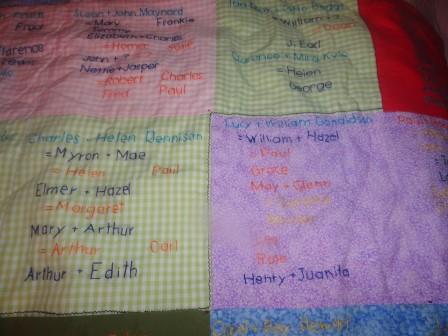
Not long ago, I came across this article from a local news outlet about the White family celebrating its 104th reunion. That’s quite an accomplishment, but what really caught my eye was the heirloom on display: a family tree quilt so large it couldn’t easily fit in a single photograph.
I tracked down the designer and creator of the family tree quilt. She’s a busy young mom named Jennifer Reiter. “Before we had our 100th reunion, I was reading a book with my girls about pioneer days,” she says. “A little girl was traveling. When they arrived at their destination, they made a quilt with all the memories from their favorite dress material. I got a crazy idea to do something like that for our family’s 100th-anniversary reunion: a quilt with everyone’s names on it.”
 It wasn’t an easy undertaking. Jennifer took the names from a family history book her mother-in-law had. The founding couple from the 1700s had four children. Jennifer designed the quilt such that each quadrant of the quilt would represent one branch of the family. She sketched out her design across 46 pages from a notebook. Then she copied everyone’s names onto quilt block templates that were sent each out to volunteers in the family to help hand-stitch.
It wasn’t an easy undertaking. Jennifer took the names from a family history book her mother-in-law had. The founding couple from the 1700s had four children. Jennifer designed the quilt such that each quadrant of the quilt would represent one branch of the family. She sketched out her design across 46 pages from a notebook. Then she copied everyone’s names onto quilt block templates that were sent each out to volunteers in the family to help hand-stitch.
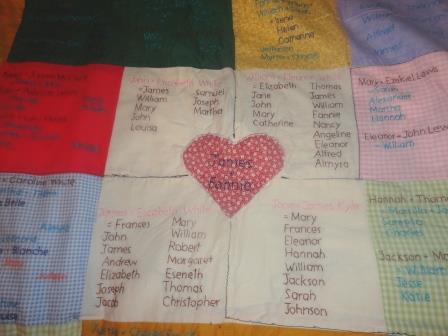 All the descendants’ names are on the quilt, Jennifer reports. “Each family unit appeared on one square. If a child got married and had a family, they got another square of their own. Each generation was a different color thread. My color is orange, so I can easily see who else is from the same generation I am. I tried to keep the colors of the fabric about the same, family-wise, too.”
All the descendants’ names are on the quilt, Jennifer reports. “Each family unit appeared on one square. If a child got married and had a family, they got another square of their own. Each generation was a different color thread. My color is orange, so I can easily see who else is from the same generation I am. I tried to keep the colors of the fabric about the same, family-wise, too.”
“It took a year,” Jennifer says. “I didn’t get quite as much help as I 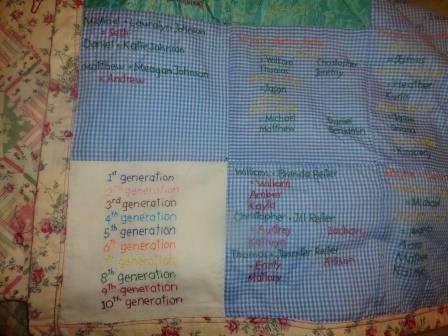 thought I would.” The final quilt documents 9 generations with 2601 names in it on a quilt that’s larger than king-sized. There are 256 quilt blocks, each of them 6″ square.
thought I would.” The final quilt documents 9 generations with 2601 names in it on a quilt that’s larger than king-sized. There are 256 quilt blocks, each of them 6″ square.
The quilt made its debut appearance at the 100th White family reunion, and a few years since then. It also took an honorable mention in the county fair. But she learned a lesson about letting it out of her sight too often: “There were a few years it was missing after it got left at the reunion. Someone went to the camp and they were looking for it again. The secretary had it. Now I have it my possession permanently.”
What an amazing accomplishment–and what an heirloom for the White family! Thanks for sharing it with us, Jennifer.
More Inspiring Family Quilts from Genealogy Gems
 A New Heritage Quilt from Old Family Fabrics (with an entire wedding dress sewn into it!)
A New Heritage Quilt from Old Family Fabrics (with an entire wedding dress sewn into it!)
A Photo Quilt Stitches Together Childhood Memories
A Quilt that Brought My Family Together (story in free Genealogy Gems podcast)
by Lisa Cooke | Jan 27, 2016 | 01 What's New, Google Earth, Listeners & Readers, Maps, Research Skills
Use Google Earth for genealogy to find long-lost family locations on modern maps. Here’s how!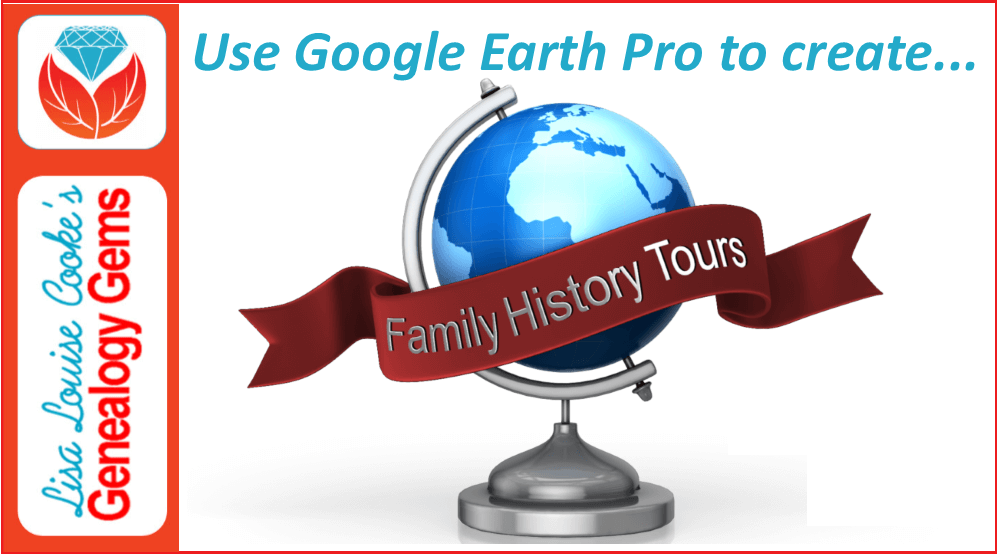
It can be very surprising to discover that you lived somewhere that you never knew you lived. That was the case for Professional genealogist Alvie Davidson, who recently wrote to me. He’d done some fantastic sleuthing on his own recent family history, and discovered that his family had lived in Huntsville, Alabama when he was a toddler. “This is the first I have even known they lived in Madison County, AL.” But he was not sure about how to use Google Earth to help him locate the family addresses he’d discovered.
“I have learned from the U S Government that my parents lived at (three) different addresses in Huntsville, Madison County, AL when I was a toddler in 1944….I never knew we lived in Huntsville but I learned my mother worked for munitions productions during World War II at Redstone Arsenal. She worked several months toward the end of 1944 and had to quit due to onset of pregnancy. We moved to Florida shortly after she left employment at Redstone Arsenal because we show up on the 1945 Florida State Census.”
Alvie sent me three family addresses. Then he asked for some step-by-step help instructions on how to put Google Earth to work to identify their location today.
4 Steps to Revealing More with Google Earth
1. Search each address in Google Earth. Enter the address in the search box in the upper left corner of Google Earth. If you get a hit, mark it with a placemark (clicking the button that looks like a push pin in Google Earth’s toolbar) and name it. In this case I found two of the three street addresses.
2. Locate a map of the area for the appropriate time period. With a little Google searching, I found the 1940 census enumeration map for Huntsville at the National Archives website. Here’s what that map looks like. (Image right) I then went in search of each of the three addresses on the map.
In this case, I conducted a block-by-block search of the 1940 enumeration district map for the missing address: 110 Winston Street. Unfortunately, not all the street names were clearly legible on this particular map, and I was unable to locate it.
You can learn more about locating enumeration district maps in my article How to Find Enumeration District Maps.
Genealogy Gems Premium Members: log in and watch my Premium video 5 Ways to Enhance Your Genealogy Research with Old Maps featuring instruction for locating and using enumeration district maps.
3. Overlay and georeference the enumeration district map in Google Earth to compare the past to the present. Georeference just means to match up known landmarks on the historic map with physical locations on the modern-day map, thereby allowing you to match the two maps up together. By so doing, I was able to locate on the enumeration district map the modern-day locations of the two addresses that I found using Google Earth.
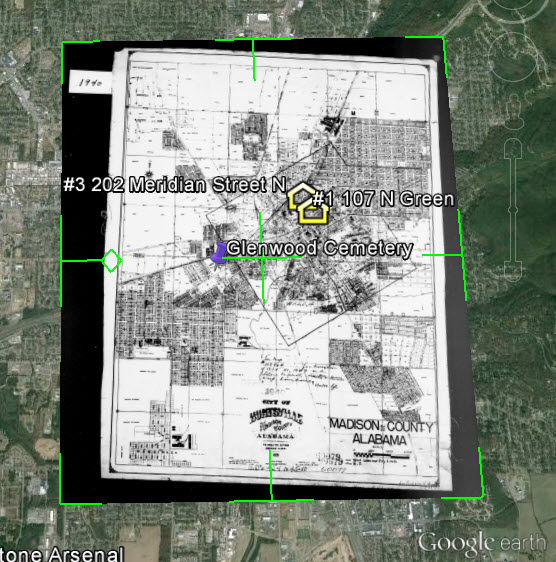
There are businesses in both locations today. Below right is a screen shot showing the current location of one of those addresses. Clearly no longer the old family home.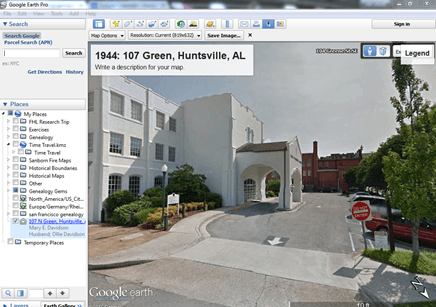
4. Dig deeper for addresses that have changed. As I mentioned previously, I searched for the 110 Winston Street address in Google Earth with no result. If that happens to you, remove the house number and run a second search on the street name alone. Numbers can change, but it is important to verify whether the street still exists today.
In this case, Google Earth did not locate a Winston Street in Huntsville, AL. Knowing that errors and typos can happen to the best of us, I ran a quick Google search for Huntsville, AL city directories, and verified that indeed Winston Street did exist at that time in history. So, at some point between 1940 and today, the name appears to have been changed.
I headed back to Google and ran the following search query:
“winston street” “huntsville alabama”
The quotation marks tell Google that each exact phrase must appear in all search results. The phrases will appear in bold in the snippet descriptions of each result.

The result above caught my eye because it mentions the “Winston Street Branch Library.” Even when street names change, buildings named for those streets often don’t. However, in this case, the website discusses the history of the library, and the Winston Street Elementary School. According to the website, the library “became a part of the Huntsville Public Library (now Huntsville-Madison County Public Library) in 1943. In 1947, the branch was renamed the Dulcina DeBerry Library.” Perhaps the street was renamed at that time as well.
Genealogy Gems Premium Members: Sign in and watch the Ultimate Google Search Strategies video class to learn more.
Jumping back into Google Earth I entered “Winston Street Branch Library” in the search box, and was immediately taken to the location, which is just south of the other two known addresses! At this point I would recommend to Alvie, who is a Genealogy Gems Premium Member, to watch my video class Best Websites for Finding Historical Maps to track down additional maps from the time frame that may have Winston Street clearly marked on the map.
Once I identified this landmark, I then marked the location with a placemark. You can turn off the 1940 enumeration district map overlay by unchecking the box next to it in the Places Panel. Doing this revealed the location on the modern day map. Finally, I headed to the Layers panel and clicked the box next to the “Roads” overlay to reveal the modern day street names.
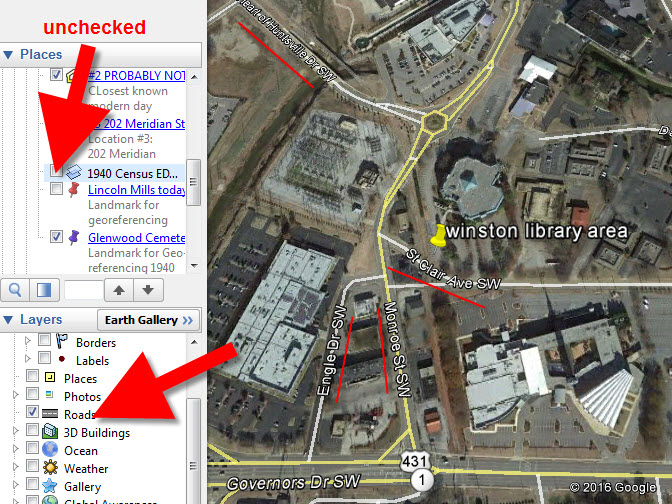
You can use this technique when you have more success than I did in finding an old address on an old map. Overlay the map, position a placemark on the location, and then turn the overlay off. With one click of the Roads layer you can now see the current street name for the old location you found on the map overlay.
Further digging online did deliver additional maps from the era and area:
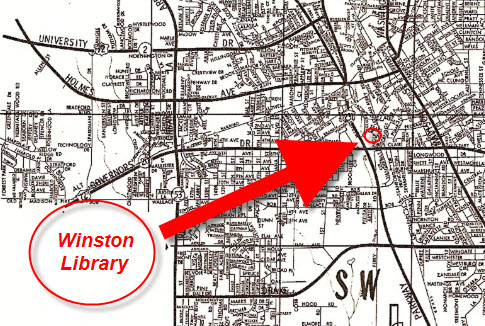
We all have locations in our family history that have given way over time to new buildings and parking lots. By using the power of Google Earth, Google search, and historic maps, they don’t have to be lost forever.
Get Started with Google Earth for Genealogy
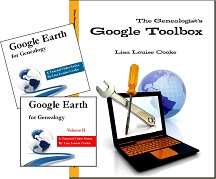
Learn all these Google skills–with step-by-step tutorials and video demonstrations–in Lisa’s book and Google Earth video tutorial. Click here for a special price on the bundle!
FREE video: Get Started with Google Earth for Genealogy
Google Bundle! The Genealogist’s Google Toolbox Second Edition PLUS learn how to create your own historical map overlays in my Google Earth for Genealogy 2-video CD set.
Use Google Earth to Plot Your DNA Matches
by Lisa Cooke | Dec 31, 2013 | 01 What's New, Ancestry, Family History Podcast, FamilySearch, MyHeritage, Trees
 Originally published 2009
Originally published 2009
Republished December 31, 2013
https://lisalouisecooke.com/familyhistorypodcast/audio/fh12.mp3
Download the Show Notes for this Episode
Welcome to this step-by-step series for beginning genealogists—and more experienced ones who want to brush up or learn something new. I first ran this series in 2008-09. So many people have asked about it, I’m bringing it back in weekly segments.
Episode 12: Post Your Family Tree Online
In this episode we focus on posting your family tree online. There’s no use in re-inventing the research wheel! By posting what you know about your family tree online you can easily connect with others who are researching people in your family tree. You can share information, collaborate and even get to know distant relatives.
Updates and Links
A few things have changed in online family tree services, including the 2013 acquisition of Geni.com by MyHeritage and the end of GeneTree. Check out these great sites for creating free family trees (you will need to create a free login to use these sites):
Ancestry.com
FamilySearch.org
Geni
MyHeritage
Mocavo

 Solve more family history mysteries with Lisa Louise Cooke’s top-selling book, The Genealogist’s Google Toolbox (2nd edition). This “Google bible” for the genealogist tells you everything you need to know to master Google’s many powerful tools. Step-by-step instructions, clear illustrations and inspiring examples will teach you how to get the most out of Google searching (even for common surnames), Google Earth, Google Books, Google Scholar, Google Alerts, Google Translate and even YouTube.
Solve more family history mysteries with Lisa Louise Cooke’s top-selling book, The Genealogist’s Google Toolbox (2nd edition). This “Google bible” for the genealogist tells you everything you need to know to master Google’s many powerful tools. Step-by-step instructions, clear illustrations and inspiring examples will teach you how to get the most out of Google searching (even for common surnames), Google Earth, Google Books, Google Scholar, Google Alerts, Google Translate and even YouTube.

 It wasn’t an easy undertaking. Jennifer took the names from a family history book her mother-in-law had. The founding couple from the 1700s had four children. Jennifer designed the quilt such that each quadrant of the quilt would represent one branch of the family. She sketched out her design across 46 pages from a notebook. Then she copied everyone’s names onto quilt block templates that were sent each out to volunteers in the family to help hand-stitch.
It wasn’t an easy undertaking. Jennifer took the names from a family history book her mother-in-law had. The founding couple from the 1700s had four children. Jennifer designed the quilt such that each quadrant of the quilt would represent one branch of the family. She sketched out her design across 46 pages from a notebook. Then she copied everyone’s names onto quilt block templates that were sent each out to volunteers in the family to help hand-stitch. All the descendants’ names are on the quilt, Jennifer reports. “Each family unit appeared on one square. If a child got married and had a family, they got another square of their own. Each generation was a different color thread. My color is orange, so I can easily see who else is from the same generation I am. I tried to keep the colors of the fabric about the same, family-wise, too.”
All the descendants’ names are on the quilt, Jennifer reports. “Each family unit appeared on one square. If a child got married and had a family, they got another square of their own. Each generation was a different color thread. My color is orange, so I can easily see who else is from the same generation I am. I tried to keep the colors of the fabric about the same, family-wise, too.” thought I would.” The final quilt documents 9 generations with 2601 names in it on a quilt that’s larger than king-sized. There are 256 quilt blocks, each of them 6″ square.
thought I would.” The final quilt documents 9 generations with 2601 names in it on a quilt that’s larger than king-sized. There are 256 quilt blocks, each of them 6″ square. A New Heritage Quilt from Old Family Fabrics
A New Heritage Quilt from Old Family Fabrics






